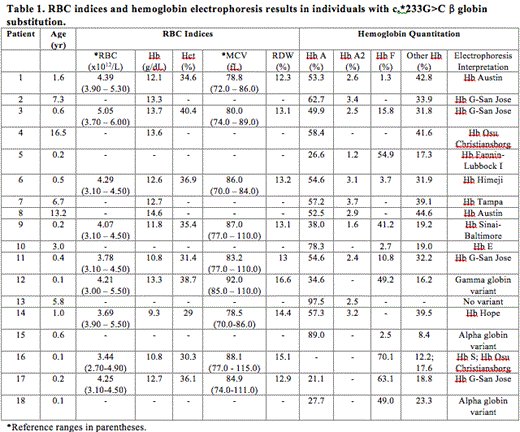Abstract
Purpose:
The c.*233G>C nucleotide substitution in the HBB gene was recently proposed as a novel β thalassemia allele based on genetic analysis of 11 thalassemic individuals. Based on this single report, the c.*233G>C allele has been provisionally included as a β (+) thal allele in a commonly used β globin database (HbVar).
The c.*233G>C is frequently seen in HBB gene sequencing for hemoglobinopathies. A clinical review was performed to determine the phenotype and hematologic characteristics of the c.*233G>C nucleotide substitution.
Methods:
At a tertiary-care pediatric institution, a retrospective review was performed of all HBB gene sequencing tests over a 30-month period. A chart review was performed for all cases with the c.*233G>C variant.
Results:
Of a total of 104 HBB cases, the c.*233G>C variant was identified in 18 individuals; 17 were heterozygotes and 1 was a homozygote (Patient 17) (Table 1). HBB gene sequencing was performed as part of the work-up for suspected variant hemoglobin (Hb) but can detect non-coding alterations including β thalassemia alleles as well.
Red cell indices in our series (Table 1) do not demonstrate the characteristics of heterozygous β thalassemia (microcytosis, mildly elevated RBC count, and mild anemia). MCV and RBC count data available for 9 individuals showed MCV values in the normocytic or macrocytic range and RBC counts within the normal range for all 9 patients. Of 13 patients with recorded Hb values, only one patient (Patient 14) was anemic but was found to have iron deficiency.
The patients in our series did not have elevated Hb A2, which in patients with β thalassemia is typically above the normal range (>4%); the 9 patients who could be evaluated for Hb A2 had values ranging from 2.4% to 3.7%. The remaining individuals were either too young to be evaluated for Hb A2 or possessed a variant Hb that co-eluted with HbA2.
The 13 patients in our series who were heterozygous for a Hb variant showed no excess in the variant Hb relative to Hb A. In patients with compound heterozygosity with a β thalassemia allele, the amount of the variant hemoglobin typically exceeds the amount of Hb A.
Conclusions:
Red cell indices and Hb proportions in this series of 18 individuals with c.*233G>C substitution are not consistent with a thalassemic phenotype. Our analysis supports a hypothesis that c.*233G>C substitution is not a β (+) thalassemia allele but is rather a fairly common benign polymorphism. This information has important implications in the diagnosis and genetic counseling of individuals with the c.*233G>C substitution.
References:
1. Sirdah et al. The spectrum of β-thalassemia mutations in Gaza Strip, Palestine. Blood Cells, Molecules and Diseases. 2013; 50: 247-251.
2. HbVar: A Database of Human Hemoglobin Variants and Thalassemias. http://globin.cse.psu.edu/hbvar/menu.html.
No relevant conflicts of interest to declare.
Author notes
Asterisk with author names denotes non-ASH members.


This feature is available to Subscribers Only
Sign In or Create an Account Close Modal